The game in the subject box is the one about the travel magazine hiring a photo assistant and writing assistant covering either Romania, Spain, or Tuscany..
I'm having some difficulty with this particular game. Can anyone enlighten me on the key inferences I am missing? I got 21 and 23 wrong during my practice test and got all of them right after un-timed review of game.
I know spent far longer than 8:45 on this game during the test so I am pretty uncertain I am overlooking something.
Inferences:
G and L cannot go to the same location
Any help would definitely be appreciated.
Also, what type of game is this? balanced moving grouping?
Game #4 June 2010 LSAT Forum
- timmydoeslsat

- Posts: 148
- Joined: Wed Aug 03, 2011 2:07 pm
Re: Game #4 June 2010 LSAT
I will post my diagram and thoughts of the game as well as a thorough explanation of each question.

This is simply listing all of the variables in the game. We know that from the rules we are going to have six people covering three stories. Each story will contain two people, one P, and W. So we know that this is the sense of order in this game, which gives us a base to create a global diagram.
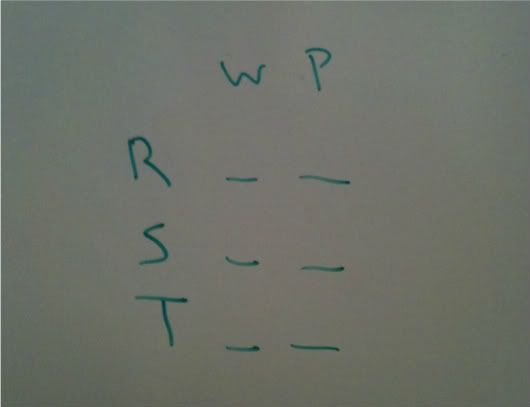
As of now, this is our global diagram before we glance at the rules, which is sure to alter this setup that we have now.
The first rule tells us that G and L will be trained in the same field. We know that there are two field, P and W. We also know that each field will have 3 members to each side. So as of now, we know 2 of the 3 of one side. We do not know what to call that side, but we do have two members of it nonetheless.
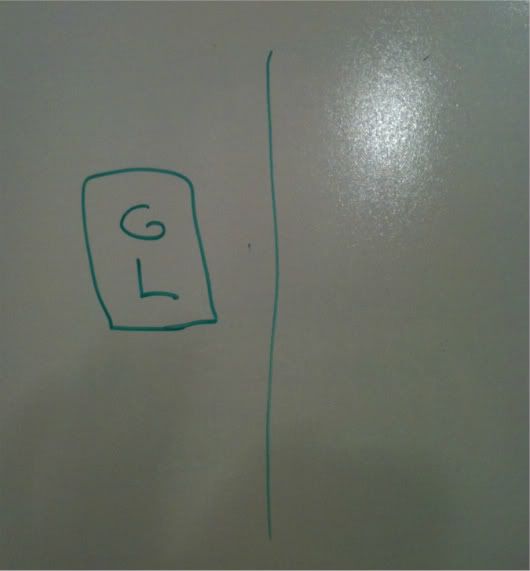
The next rule tells us that F and K are trained in different fields. This means that the field containing G and L is now full, as it must accommodate one of F and K, while the other side accommodates the other part of F and K.
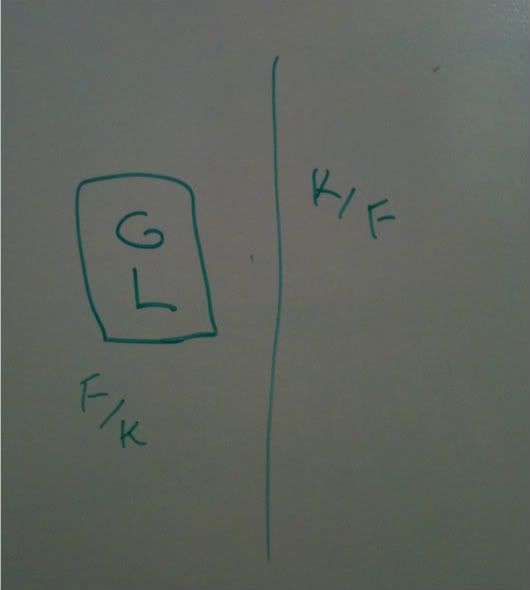
We now know that any variables left that have not been placed, must be placed together on this other side. These two variables are H and J.
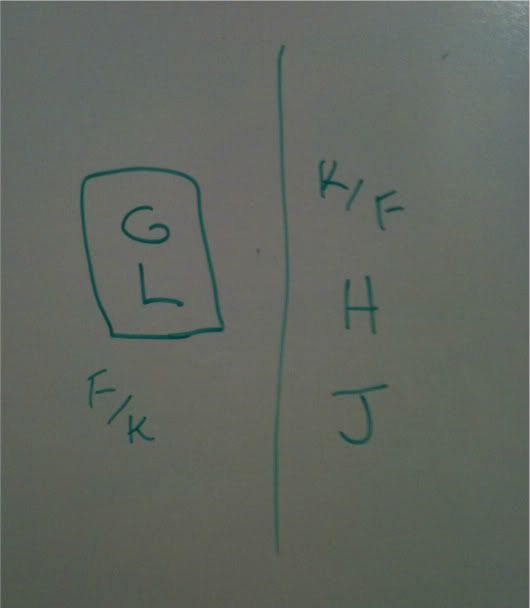
The next rule tells us how to label the two sides. The rule states that H will be a P. That means that other side must be a W.
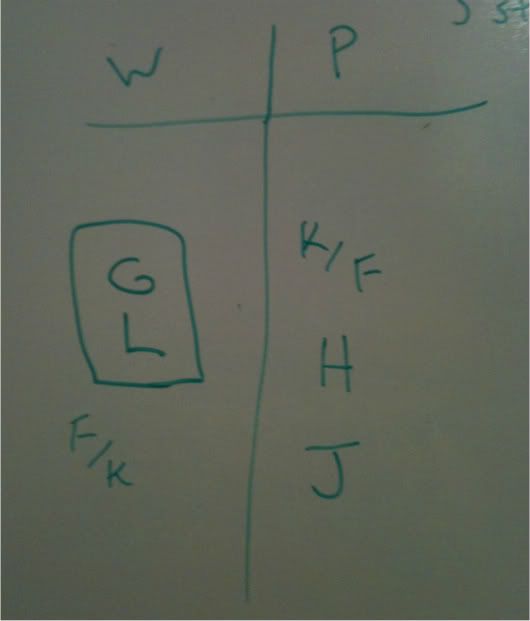
Our last two rules are for the global diagram we created earlier. We will place a not rule with K at S. We will also plug in J at the S spot as a P. Notice that I keep a consistent W-P structure. The left side of my global diagram is a W and the left side of my team diagram is a W. This is so I do not make a careless mistake by misreading the two sides.
This is what our completed global diagram looks like after the rules.
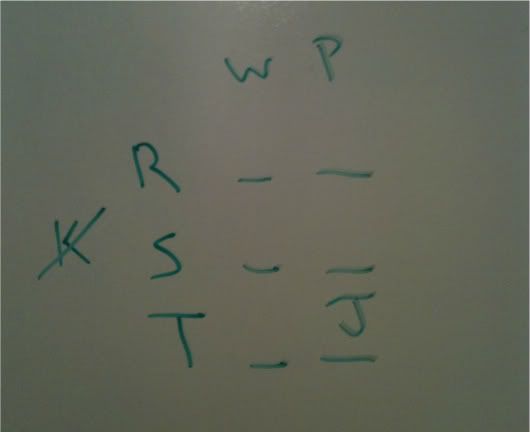
The first question is a hypothetical lineup question, in which you would simply apply the rules. I will not go over this one because I believe you have a firm handle on these types of questions.
#19 gives us a local rule of F being assigned to R.
I simply constructed two hypotheticals side by side with F being in R as a W and then as a P to quickly and efficiently arrive at an answer.
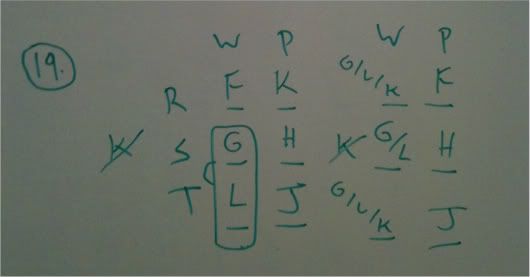
The box with the curve on it in that left hand diagram indicates that those variables within that box can swap. I sometimes show this by dual options, but lately I have been doing this as it is easier to see visually to me.
#20 gives us another local rule of F and H being assigned to the same story, this means that one is a W and one is a P. This will form a horizontal block. We know that H is a P, so that means that F is a W. Since F is a W, we know that K must be the opposite of that, which is a P.
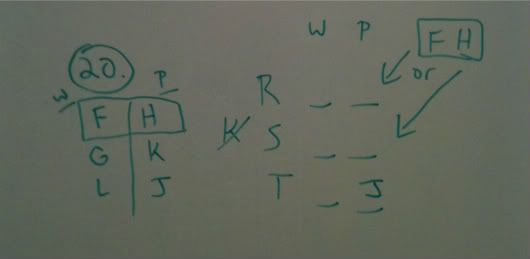
Notice that since we know that J is a P in T, we know that the block cannot go in T. That means this FH block must either go in R or S. We know that K cannot go in S. We know that K is a W in this question. So we know that the FH block could not go in row R because then K must fill the W spot in S. So the the FH block must go in S.
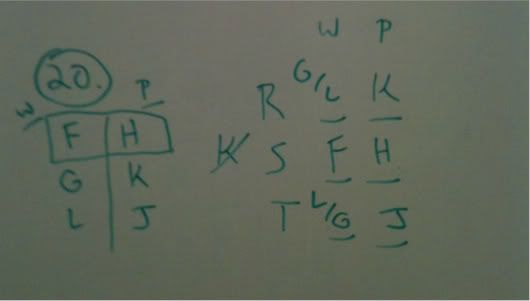
With the FH block being in row S, we know that K must go as a W in row R. The only variables left to place are G and L. These two variables are interchangeable. There are no rules that make the two any different from one another. Thus, we can show a dual option as I did above.
#21 gives us another local rule of F being a W. It asks us which one of the five answer choices could be a pair of writers for R.
With F being a W, we know that K is a P.
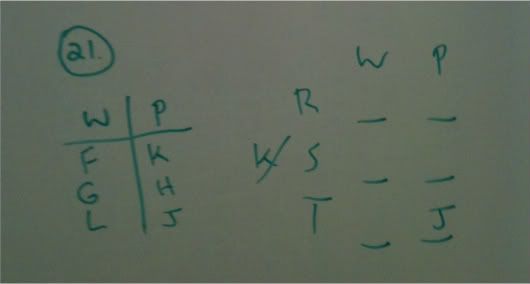
This shows how I approach this question. I want to place a team diagram near my recreated global set up that will be altered to show the local rule.
I know that K cannot go in S, so it must go in R as a P. This would then force H into S. I have my column of P's done. I know need to figure out my W column.
I know that my W column must consist of F, G, and L. However, there are no rules governing or restricting where I must place them. Thus, I will show that anything can happen with it.
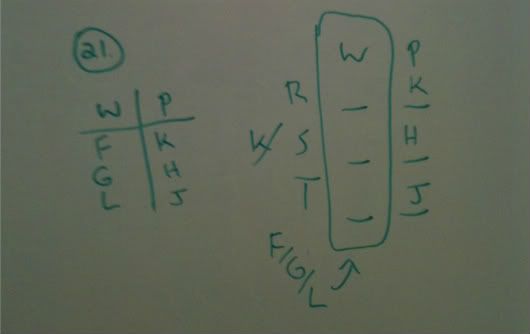
I know that the team of R must consist of K. Only two answer choices have K, which is C and D. The difference between those two answer choices are H and L. I know that H cannot be it, and that L is shown by my work to be a possibility.
#22 gives me another local rule of G and K being assigned to the same story as each other. This will create a GK horizontal block. We know that G is a W, thus we know that K is a P.

Since J is already in row T, we know that the GK block cannot go in the T row.
We know that this GK block must either go in the R row or the S row.
We know that K cannot go in the S row. Thus, the GK block must go in the R row.
We know that H is the remaining P left to place. It must go in row S.
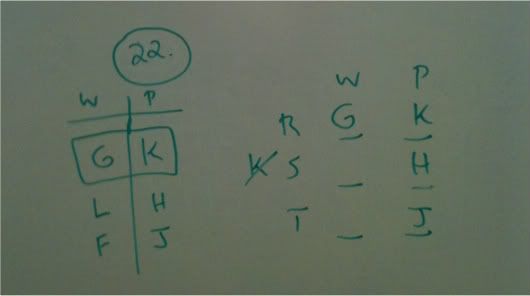
The only two variables left to place are on the W side and they are F and L. There are no rules governing their placement at this point, thus I will use my box with the curve on it to show that each variable could occupy those slots in that box.
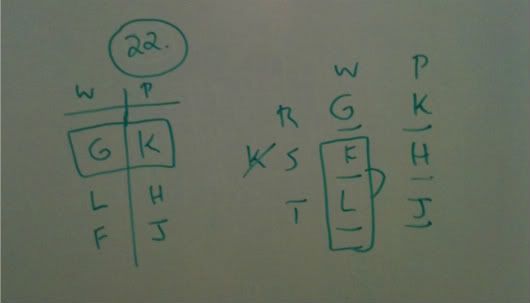
#23 is a global question. We can expect to use our global diagram to aide us in this question.
Which one of the interns cannot be assigned to T? Well we know that J is already assigned to T and that J is a P.
At this point, we can realize that having another P in T would be unacceptable, as T must have a W and P, not two P's. We know that J is the P. What other variable do we know MUST be a P?
H.
H could never be assigned to T because then T would have two P's and no W.

This is simply listing all of the variables in the game. We know that from the rules we are going to have six people covering three stories. Each story will contain two people, one P, and W. So we know that this is the sense of order in this game, which gives us a base to create a global diagram.

As of now, this is our global diagram before we glance at the rules, which is sure to alter this setup that we have now.
The first rule tells us that G and L will be trained in the same field. We know that there are two field, P and W. We also know that each field will have 3 members to each side. So as of now, we know 2 of the 3 of one side. We do not know what to call that side, but we do have two members of it nonetheless.

The next rule tells us that F and K are trained in different fields. This means that the field containing G and L is now full, as it must accommodate one of F and K, while the other side accommodates the other part of F and K.

We now know that any variables left that have not been placed, must be placed together on this other side. These two variables are H and J.

The next rule tells us how to label the two sides. The rule states that H will be a P. That means that other side must be a W.

Our last two rules are for the global diagram we created earlier. We will place a not rule with K at S. We will also plug in J at the S spot as a P. Notice that I keep a consistent W-P structure. The left side of my global diagram is a W and the left side of my team diagram is a W. This is so I do not make a careless mistake by misreading the two sides.
This is what our completed global diagram looks like after the rules.

The first question is a hypothetical lineup question, in which you would simply apply the rules. I will not go over this one because I believe you have a firm handle on these types of questions.
#19 gives us a local rule of F being assigned to R.
I simply constructed two hypotheticals side by side with F being in R as a W and then as a P to quickly and efficiently arrive at an answer.

The box with the curve on it in that left hand diagram indicates that those variables within that box can swap. I sometimes show this by dual options, but lately I have been doing this as it is easier to see visually to me.
#20 gives us another local rule of F and H being assigned to the same story, this means that one is a W and one is a P. This will form a horizontal block. We know that H is a P, so that means that F is a W. Since F is a W, we know that K must be the opposite of that, which is a P.

Notice that since we know that J is a P in T, we know that the block cannot go in T. That means this FH block must either go in R or S. We know that K cannot go in S. We know that K is a W in this question. So we know that the FH block could not go in row R because then K must fill the W spot in S. So the the FH block must go in S.

With the FH block being in row S, we know that K must go as a W in row R. The only variables left to place are G and L. These two variables are interchangeable. There are no rules that make the two any different from one another. Thus, we can show a dual option as I did above.
#21 gives us another local rule of F being a W. It asks us which one of the five answer choices could be a pair of writers for R.
With F being a W, we know that K is a P.

This shows how I approach this question. I want to place a team diagram near my recreated global set up that will be altered to show the local rule.
I know that K cannot go in S, so it must go in R as a P. This would then force H into S. I have my column of P's done. I know need to figure out my W column.
I know that my W column must consist of F, G, and L. However, there are no rules governing or restricting where I must place them. Thus, I will show that anything can happen with it.

I know that the team of R must consist of K. Only two answer choices have K, which is C and D. The difference between those two answer choices are H and L. I know that H cannot be it, and that L is shown by my work to be a possibility.
#22 gives me another local rule of G and K being assigned to the same story as each other. This will create a GK horizontal block. We know that G is a W, thus we know that K is a P.

Since J is already in row T, we know that the GK block cannot go in the T row.
We know that this GK block must either go in the R row or the S row.
We know that K cannot go in the S row. Thus, the GK block must go in the R row.
We know that H is the remaining P left to place. It must go in row S.

The only two variables left to place are on the W side and they are F and L. There are no rules governing their placement at this point, thus I will use my box with the curve on it to show that each variable could occupy those slots in that box.

#23 is a global question. We can expect to use our global diagram to aide us in this question.
Which one of the interns cannot be assigned to T? Well we know that J is already assigned to T and that J is a P.
At this point, we can realize that having another P in T would be unacceptable, as T must have a W and P, not two P's. We know that J is the P. What other variable do we know MUST be a P?
H.
H could never be assigned to T because then T would have two P's and no W.